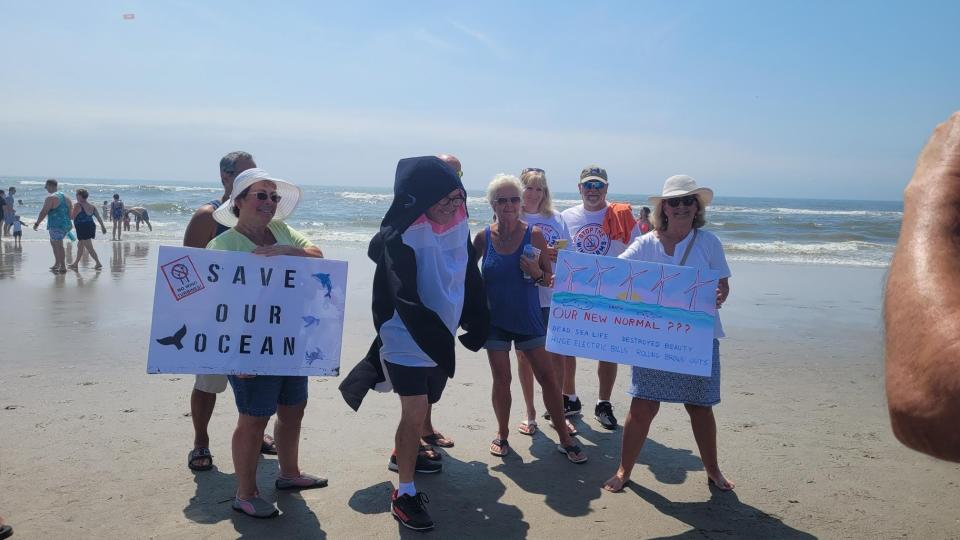Opposition to offshore wind lands on South Jersey beaches
Whether you're on the beach soaking up rays, sifting through your beach town's Facebook group or just driving around Absecon Island, you've most likely seen some conversations about offshore windmill farming at the Jersey Shore.
A parade of protesters took to New Jersey's shores on July 15, carrying large posterboards covered in phrases like "Why," "Save our ocean," and "Stop killing us" along with infographics.
This event, called "Hands Across the Beaches," was planned for over 25 New Jersey beaches with people turning out to link hands in protest and share their disapproval for the project.
Kathleen Harper is the brains behind the event, though she said that it was the work of many individuals and groups to make it happen.
Harper grew up in Marmora and spent her summers at 34th Street Beach. She said that she first became involved in this issue when whales and dolphins started dying, and then she began attending meetings and joining anti-wind groups.
"I decided we needed to inform citizens about wind farms and the dangers that come with them, so I suggested Hands Across the Beaches in all the groups I joined, and they all put it together and made it great," Harper said.

So, are offshore windmill farms really coming to Jersey, and why are people so upset?
What is Ocean Wind 1?
On July 5, The Department of the Interior's Bureau of Ocean Energy Management announced its approval for the constructions and operations plans of Ocean Wind 1, an offshore clean energy project in New Jersey.
According to the DOI's press release, the project will take place about 13 nautical miles off the coast of Atlantic City, and it will have an estimated capacity of 1,100 megawatts of clean energy, meaning it is capable of powering roughly 400,000 homes. The three-year construction cycle is expected to create over 3,000 well-paying jobs.
This is the third approval of a commercial-scale, offshore wind energy project from the Biden-Harris Administration, moving toward a goal of developing 30 gigawatts of clean, renewable offshore wind energy by 2030.
The Ocean Wind 1 project comes from Orsted, a U.S. clean energy company headquartered in Denmark.
But despite the anticipated boost to the job economy and sustainable energy resources, some people, especially those who live down the shore, are less than thrilled.
Gripes with offshore wind energy
Like any major changes, there are bound to be disagreements and concerns. But what specifically about the offshore wind energy project has gotten people to whip out their posterboards?
Well, Protect Our Coast New Jersey (POCNJ), a nonprofit dedicated to stopping to construction and approval of the offshore wind farm, cites environmental concerns, worry for boating, fishing and hospitality industries, as well as property values, as just some reasons to shelf the project.
A Change.org petition started in January has already amassed over half a million signatures.
"We state here that there are many other strategies that can generate energy in a safer and more environmentally favorable way, so that New Jersey's greatest natural resource is not put at risk," the petition states, addressed to both President Joe Biden and New Jersey Governor Phil Murphy.
One strategy protestors are supporting? Nuclear power.
"I think nuclear is the best thing," said Lynn Petrulio of Ocean City. "I think its reliable. I think we've proven that its safe."
The POCNJ Facebook group, a public group where people can communicate and share information, continues to be inundated with graphs, conversations and screengrabs of various planning documents to inform others of concerns with the project.
"A lot of it is in the fine print, but it's there," Petrulio said of the foreseen potential for adverse impacts. "We were just sold a bunch of malarkey."
Concerns vary from reports of marine species deaths that some worry could be from sonar testing used in construction as well as information from the Ocean Wind 1 Environmental Impact Statement that list adverse impacts common in both proposed and No Action Alternative projects.
These include things such as displacement and avoidance behaviors from birds due to habitat loss and alteration, disruptions to commercial fishery harvesting during construction, increased risk of injury and mortality for marine mammals and disruptions to activities like beach access during construction.
As more pieces fall into place for the Ocean Wind 1 to set sail, many people are continuing their conversations about their environmental and economic concerns, and adversaries are walking the wire as the project looms closer.
This article originally appeared on Cherry Hill Courier-Post: What is Ocean Wind 1 and why are people protesting?

